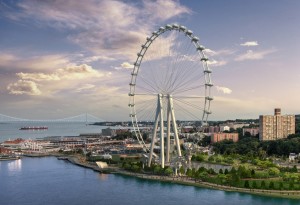Observation Wheel Design
There is not a general process when it comes to designing a giant observation wheel – every one is unique. The idea may stem from a variety of different sources. Sometimes a city initiates the project. For example, the location of the observation wheel may be city owned land and the developer leases the land from the city and there could also be a revenue sharing scheme. Other times the project is entirely owned by a private developer. But even in that case, there is a requirement for permitting. The city, or whatever government authority has jurisdiction, has to approve the project, permit, make sure it meets the zoning laws, make sure there are adequate fire, police and transportation resources.

Once the location ob the future observation wheel is chosen, the first step is to apply to the FAA for a No Hazard Determination. The FAA will take the data from the project including the GPS location, the details of the project such has height, profile, etc. and reach out to as many as sixteen government organizations to make sure the project will not interfere with aviation. The structure obviously cannot be in the flight path of a local airport.
Modern observation wheels are designed and assembled by a team of individuals, each with a specific job and responsibility. What kind of jobs are these?
- Wheel Design and Manufacturing
- Architects
- Landscape Architect
- Environmental Consultant
- Civil Engineer
- Traffic Consultant
- Structural Engineer for Terminal & Parking
- Land Use Counsel
- Real Estate Counsel
- Project Advisor
- Sustainability Consultant
- Wheel Operations Consultant
- Project Manager
- Surveyor
- Geotechnical Engineer
- Construction Manager
- Expeditor
- Code Consultant
- Lighting Designer
- Security
- Sponsorship Consultant
- Market Study Consultant
- Marketing Consultant
- Website Development
- Ventilation Consultant
As you can see, observation wheel design requires input from numerous fields of study.